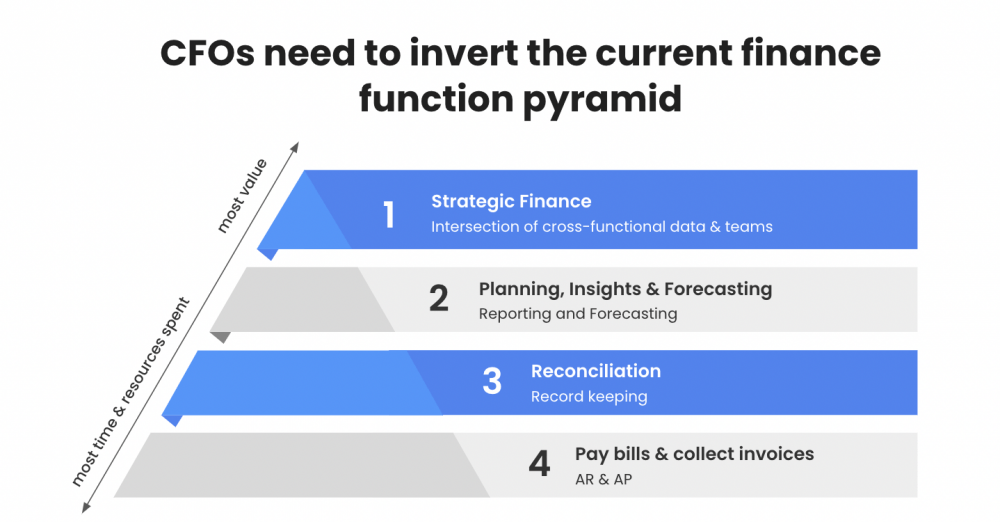Peakflo Panel: How to Future-proof Your Finance Function
SINGAPORE, SEPTEMBER 21st, 2022 — Peakflo conducted a live panel session at the Accounting and Finance Show 2022, featuring:
- Saurabh Chauhan, Co-founder and Chief Executive Officer at Peakflo
- Joscel Delos Cielos, Director of Finance at eTaily
- Lee Che Meng, Co-Chief Operating Officer at Pickupp
- Auro Sen, Head of Finance and FP&A at Ula
The panel goes into the depth of the company’s biggest finance function challenges, which translate into broader financial issues. Moreover, in today’s landscape of economic downturn and massive layoffs, future-proofing your finance function is essential for all companies to survive and thrive.
What are the biggest challenges faced by the finance and operational teams?

The companies’ finance ops challenges could be summarized into three main pain points:
- Collections. In Pickupp’s case, roles outside of the finance team, such as business and account managers, are occupied with invoice follow-ups instead of building revenue.
- Billing and invoicing. Doing plenty of activities for their clients, etaily requires a system to centralize all sources of truth to ensure maximum accuracy with their invoice processes. In addition, manual billing will not be sustainable especially as the company is scaling.
- Order management and payments. Working with a lot of suppliers across the B2B sector, Ula’s time is wasted on processing multiple invoices daily. The majority of their customers are conventional and prefer to pay via banks instead of modern getaways. To counter this, raising headcounts may deem to be promising at first, but eventually not scalable.

As seen from the pyramid of the finance function — most finance operational teams end up spending their time on tasks that have the least amount of value, such as collecting outstanding invoices, making payments to vendors, reconciliation, and month-end closing.
However, high-value tasks that will support the company’s growth, such as strategic finance, cross-functional data, planning, and forecasting, receive the least to even no attention.
Considering the toll this is taking on the organization, finance leaders need to find a way to invert and optimize this pyramid.
Why should you care about putting your accounts receivable and payable on autopilot?
Of course, tasks such as manual reconciliation, record keeping, and manual AR & AP processes are costing companies significantly across different aspects:
Loss of opportunity costs
For Pickupp, the system of communication between the finance and commercials team was scattered. As a result, a pile of invoices was overdue, and the account managers were busy chasing late payments instead of spending their time working on new deals and creating growth opportunities.
According to Lee Chee Meng, around 30% to 40% of his account managers’ time goes into communicating with the clients, handling disputes, and manually following up on their clients to make payments on overdue invoices.
Increase in fixed costs
Joscel also maps how inefficient payable and receivable management can negatively impact three significant points:
- Profit and Loss (P&L). Regardless of your company’s position, if you’re not automating, your company will have a hard time keeping up with the growth of the fixed costs due to the high contribution margin.
- Cash flow. Given the current macroeconomic condition, companies need to extend their runway with effective AR and AP management.
- Fundraising or valuation. It’s recommended for companies to start AR & AP automation in the early stages to help extend their runways because accounts payable and receivable automation can directly affect the working capital and cash conversion.
Also Read: How to Survive Funding Winter by Streamlining Finance operations
Decrease in GMV (Gross Merchandise Value) or revenue
As the volume of invoices scales, more man-power is added to process the same or higher number of invoices to manage the entire billing process. For an early-stage startup, 2 to 5% of the revenue can contribute to the receivables and payables. Alluding to the previous point, the heightened demand for human resources will take away a significant portion of the company’s gross merchandise value.
Increase in churn rate
All companies agree that repetitive processes do not give justice to people management and can negatively impact employees’ productivity, well-being, and retention.
Auro explains that to prevent such a situation, companies need to understand how to wisely utilize the bandwidth of employees whose time has been freed by automation.
Leaders can assign their employees more diverse tasks, such as payment reconciliation or dashboard maintenance, to help their development. Chee Meng notes that in general, people like to be challenged. Automation can help employees spend their time more efficiently and productively. Leaders must equip their employees with the right tools to support their growth.
It’s interesting to see the contrast between how inefficient finance operations can negatively impact the internal component of the company in terms of rising in costs and churn rates.
While it’s hard to account for acquisition and employee happiness, there has been data from broader publications proving how AR and AP delay cost companies a lot.
According to Quickbooks and BusinessWire, around 52 workdays are spent on manual payables tasks, and 72 workdays are spent on chasing overdue invoices.
How to automate AR and AP without disrupting finance processes?
- Incremental improvements. Slowly shifting from manual to full automation is the way for etaily. In terms of internal discussion (with C-Level or commercials team), provide actual data to eliminate uncertainties: automation can help increase the cash conversion cycle and extend the runway.
- Balance between maximum impact and low effort is possible with automation. Automation can be a small cost compared to the costs for internal bandwidth. Cloud tools are not a burden to manage and support is always available to quickly onboard the employees.
For growing startups, in the first to two years, it’s best to automate their finance ops. It’s the simplest, most cost-friendly, and employee-friendly option.
Build vs Buy: How do finance leaders finally settle on a decision?
A lot of times, companies tend to lean toward building AR & AP automation internally. But, finance leaders need to do some cost-to-benefit analysis which can be mapped out in the following points:
- Take into account the time or budget that will be spent on building an AR & AP automation tool. Could that time and budget contribute to a higher-value task instead of building a solution internally?
- Buying accounts payable and receivable automation is a viable solution when contributing to top-line growth rather than bottom-line for companies and it can directly impact revenue growth.
- If the company needs an immediate solution and it’s not feasible to build a tool for AR and AP automation, then buying the right tool for automation is a definitive option.
- Look into the FPE (Forward Price to Earning) analysis of the technicality. If the result is more than 60%, having an AR and AP automation is urgent to prevent further mistakes and back-and-forth internal communications.
Are you a finance leader and is your company dealing with the same issues? Future-proofing your finance functions with automation will help your business grow.
Read our case studies and find out how other fast-growing businesses are using automation to thrive even during the most difficult and uncertain times.













































